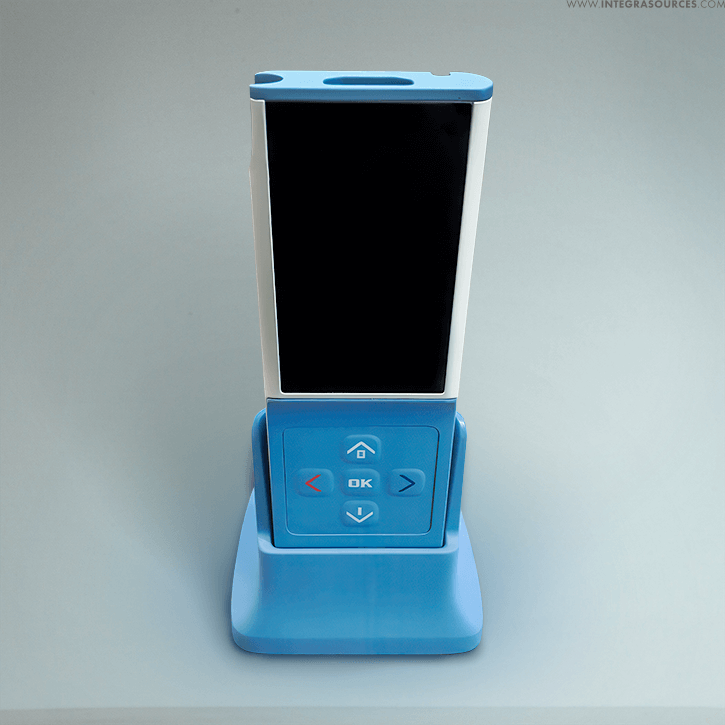Otoacoustic Emission System
Background
Otoacoustic Emissions (OAEs) are sounds produced by the tiny hair cells inside the cochlea when they respond to incoming sound signals. This test is a key diagnostic tool in audiology.
It’s commonly used to screen newborns and monitor hearing health in people regularly exposed to noise. By quickly identifying hearing issues, it helps healthcare providers take early action, which is crucial for effective treatment and improving quality of life.

Request
Our client, a major supplier of medical equipment, decided to expand into manufacturing and approached us with an idea to develop a portable system for recording evoked otoacoustic emissions (OAEs).
The goal was to create a device that would rival the features and specifications of internationally established models.
Solution
The system includes a compact device for hearing screening, a specialized probe with disposable ear tips in various sizes, and a Bluetooth-enabled thermal printer for result output.
How it works: A medical specialist inserts the probe into the patient’s ear and runs the screening. Results can be saved directly to the device or sent via Bluetooth to the printer.

Device Features:
- Size: 72x35x155 mm (2.8x1.4x6.1 inches).
- Durability: Dust and moisture-resistant (IP40) with a 2.4'' color display.
- Functionality: Includes a probe port for tests and tactile buttons for menu navigation.
- Connectivity: USB-C port and Bluetooth-enabled data transfer to the printer.
- Language Support: English, Spanish, French, with options to add more languages.
- Storage: Internal memory for test templates, results, and patient data.
- Power Efficiency: Runs on a rechargeable battery with ultra-low standby consumption of only 8 µA.

The device operates with two microcontrollers. The primary GD32 microcontroller handles the main functions of the device. The secondary microcontroller is responsible for real-time sound volume control. If a codec malfunction or software error occurs, the secondary microcontroller rapidly disables the output to prevent potential hearing damage to the patient.
Probe
Probe Features:
- Fits into the patient’s ear;
- Comes with disposable parts: tubes and ear tips in different sizes;
- Integrates two speakers to emit sound signals and two precision microphones to record otoacoustic emissions from the ear’s response.
An automatic positioning algorithm ensures proper probe placement. It generates a test signal, analyzes the response wave, and evaluates amplitude-frequency characteristics to provide feedback:
- Correct probe placement;
- Seal integrity compromised;
- Obstruction detected (e.g., contact with the ear canal wall or external objects).
Competitive Advantages of Our Device
No DSP Processor
Our device processes digital signals directly through the main microcontroller, eliminating the need for a separate DSP processor. This approach reduces production costs since DSP processors are often among the priciest components in similar systems. Plus, it simplifies PCB development.
Enhanced Probe Design
While competing devices typically feature one speaker and one microphone, our probe includes two speakers and two microphones with differentiated specifications to enhance testing quality. The dual-speaker setup minimizes intermodulation distortion by delivering different frequencies to each speaker, resulting in cleaner, more accurate signals and improved test reliability.
Better Screen, Better Data
Our screen outshines competitors with its larger size and better colors. It displays more data during tests, including emission levels at various frequencies and a resulting amplitude-frequency graph.
This visual comparison of emission levels against noise detected by the microphone allows instant determination of test results. Specialists can analyze responses in detail using the frequency-specific data for quick evaluations.

Test report screen
Patient Data Storage
The LittleFS lightweight filesystem, optimized for microcontrollers, initially stored the patient list in one file and all research data for all patients in another. As patient numbers and studies scaled up, this caused significant slowdowns in file processing.
Our approach:
We adopted a "one patient, one file" strategy, creating a separate digital dossier for each user. This way, the system doesn’t waste resources scanning the whole database—it just pulls up the specific file it needs.
Result:
File processing speed improved multiple times over, providing doctors with almost instantaneous access to patient data. The storage structure is now both technically efficient and intuitively user-friendly.
Analog Electronics
This device is built to study very low sound levels and uses analog electronics, where even tiny amounts of interference can mess up the results. So, we needed a special design strategy.
Engineering approach:
We carefully examined the challenges of analog design and created a device architecture that physically separates the digital and analog parts of the PCB. The analog ground connects to the main ground at a single point, which helps prevent unwanted noise and interference.
We also added a separate linear voltage regulator for the analog section, which cuts down noise and improves the overall signal quality.
Photo Storage and Decoding
When working with the OV5460 camera module, we ran into two main system limitations:
- not enough RAM to handle the camera and store patient photos in JPEG format;
- the GD32 microcontroller doesn’t have hardware support for decoding JPEGs.
Our solution:
- We dug deep into the camera’s specs and designed an optimized way for it to communicate with the microcontroller. The camera now runs in two modes—a power-saving RGB565 mode for scanning QR codes, and a full photo mode for saving JPEG images.
- After testing image quality, we set a 300 KB max photo size to strike the right balance between picture quality and flash memory use.
- Since hardware decoding wasn’t an option, we built a software decoder to convert JPEG images into RGB565 format compatible with the device display.
Scope of Work
- Schematic and PCB design
- PCB assembly, testing, and fixing
- Firmware development
- UI development
- Driver and algorithm development
Technologies
- Altium Designer for schematics and PCB design;
- Custom firmware created with C++, Visual Studio IDE, CMake cross-platform tool, and GCC compiler;
- GD32F470ZIT6 MCU, powered by the Arm® Cortex®-M4 core with a processor frequency of up to 240 MHz;
- STM32L412K8U6 for sound volume control;
- ProtoBuf protocol for data serialization;
- Display— a 2.4'' full-color 240x320 IPS screen;
- Bluetooth v5.0 module BM78SPPS5MC2-0002AA;
- Camera—OV5640 module;
- Audio Codec—ADAU1372;
- Battery—Lithium-polymer LP584265 with 2Ah capacity.
- LVGL embedded graphics library for UI;
- Algorithms: TEOAE, DPOAE, and probe positioning algorithms initially developed in Scilab and rewritten in C/C++ for device integration;
- QR code decoding with quirc library;
- 32 MB Flash ROM memory;
- Sanibtel MPT-II portable wireless thermal printer for test results.
Result
We’ve developed a medical diagnostic system that outperforms widely used international models.
Benefits for the client:
- Cost-effective: Our device is 10x cheaper than the reference international model, achieved through strategic component optimization.
- Enhanced accuracy: The advanced probe ensures more precise hearing tests.
- Data management: Test results from multiple devices can be consolidated into a unified database, organized by patient profiles.
Roadmap for development:
- Building communication algorithms for integration with external software, including medical information systems (MIS). Test data can be exported to medical databases in formats like JSON.
- Expanding storage with 128 MB flash memory to store a large volume of studies locally, ensuring data availability even offline.
You might also like...

Firmware Development for Augmented Reality Glasses
The team improved the customer’s firmware for augmented reality glasses by developing drivers for the displays, accelerometer, and gyroscope of the device. 
LEARN MORE 

Software for EEG System
The Integra Sources team developed energy-efficient embedded software and an SDK for a medical EEG system. We delivered robust data transfer and storage, implemented multitasking on FreeRTOS, and improved connection security. 
LEARN MORE 



